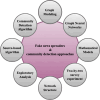Dissecting the infodemic: An in-depth analysis of COVID-19 misinformation detection on X (formerly Twitter) utilizing machine learning and deep learning techniques
- PMID: 39315207
- PMCID: PMC11417217
- DOI: 10.1016/j.heliyon.2024.e37760
Dissecting the infodemic: An in-depth analysis of COVID-19 misinformation detection on X (formerly Twitter) utilizing machine learning and deep learning techniques
Abstract
The alarming growth of misinformation on social media has become a global concern as it influences public opinions and compromises social, political, and public health development. The proliferation of deceptive information has resulted in widespread confusion, societal disturbances, and significant consequences for matters pertaining to health. Throughout the COVID-19 pandemic, there was a substantial surge in the dissemination of inaccurate or deceptive information via social media platforms, particularly X (formerly known as Twitter), resulting in the phenomenon commonly referred to as an "Infodemic". This review paper examines a grand selection of 600 articles published in the past five years and focuses on conducting a thorough analysis of 87 studies that investigate the detection of fake news connected to COVID-19 on Twitter. In addition, this research explores the algorithmic techniques and methodologies used to investigate the individuals responsible for disseminating this type of fake news. A summary of common datasets, along with their fundamental qualities, for detecting fake news has been included as well. For the purpose of identifying fake news, the behavioral pattern of the misinformation spreaders, and their community analysis, we have performed an in-depth examination of the most recent literature that the researchers have worked with and recommended. Our key findings can be summarized in a few points: (a) around 80% of fake news detection-related papers have utilized Deep Neural Networks-based techniques for better performance achievement, although the proposed models suffer from overfitting, vanishing gradients, and higher prediction time problems, (b) around 60% of the disseminator related analysis papers focus on identifying dominant spreaders and their communities utilizing graph modeling although there is not much work done in this domain, and finally, (c) we conclude by pointing out a wide range of research gaps, for example, the need of a large and robust training dataset and deeper investigation of the communities, etc., and suggesting potential solution strategies. Moreover, to facilitate the utilization of a large training dataset for detecting fake news, we have created a large database by compiling the training datasets from 17 different research works. The objective of this study is to shed light on exactly how COVID-19-related tweets are beginning to diverge, along with the dissemination of misinformation. Our work uncovers notable discoveries, including the ongoing rapid growth of the disseminator population, the presence of professional spreaders within the disseminator community, and a substantial level of collaboration among the fake news spreaders.
Keywords: COVID-19; Community analysis; Deep learning; Disseminator; Fake news; Machine learning; Misinformation; Social network analysis; Twitter.
© 2024 The Authors.
Conflict of interest statement
The authors declare that they have no known competing financial interests or personal relationships that could have appeared to influence the work reported in this paper.
Figures






Similar articles
-
Machine and deep learning algorithms for sentiment analysis during COVID-19: A vision to create fake news resistant society.PLoS One. 2024 Dec 19;19(12):e0315407. doi: 10.1371/journal.pone.0315407. eCollection 2024. PLoS One. 2024. PMID: 39700256 Free PMC article.
-
CoAID-DEEP: An Optimized Intelligent Framework for Automated Detecting COVID-19 Misleading Information on Twitter.IEEE Access. 2021 Feb 9;9:27840-27867. doi: 10.1109/ACCESS.2021.3058066. eCollection 2021. IEEE Access. 2021. PMID: 34786308 Free PMC article.
-
Fake news in the age of COVID-19: evolutional and psychobiological considerations.Psychiatriki. 2022 Sep 19;33(3):183-186. doi: 10.22365/jpsych.2022.087. Epub 2022 Jul 19. Psychiatriki. 2022. PMID: 35947862 English, Greek, Modern.
-
Fake news detection: state-of-the-art review and advances with attention to Arabic language aspects.PeerJ Comput Sci. 2025 Mar 11;11:e2693. doi: 10.7717/peerj-cs.2693. eCollection 2025. PeerJ Comput Sci. 2025. PMID: 40134874 Free PMC article. Review.
-
Fake news, disinformation and misinformation in social media: a review.Soc Netw Anal Min. 2023;13(1):30. doi: 10.1007/s13278-023-01028-5. Epub 2023 Feb 9. Soc Netw Anal Min. 2023. PMID: 36789378 Free PMC article. Review.
Cited by
-
Classifying and fact-checking health-related information about COVID-19 on Twitter/X using machine learning and deep learning models.BMC Med Inform Decis Mak. 2025 Feb 11;25(1):73. doi: 10.1186/s12911-025-02895-y. BMC Med Inform Decis Mak. 2025. PMID: 39934858 Free PMC article.
References
-
- Gorbalenya A.E., Baker S.C., Baric R.S., De Groot R.J., Drosten C., Gulyaeva A., Haagmans B.L., Lauber C., Leontovich A.M., Neuman B.W., Penzar D., Perlman S., Poon L.L.M., Samborskiy D.V., Sidorov I.A., Sola I., Ziebuhr J. The species Severe acute respiratory syndrome-related coronavirus: classifying 2019-nCoV and naming it SARS-CoV-2. Nat. Microbiol. 2020;5(4):536–544. doi: 10.1038/s41564-020-0695-z. - DOI - PMC - PubMed
-
- Thangavel V. Nomophobia in India: a psychological disorder that causes the brain to release dopamine in response to tweets, emoticons, and other acts, rewarding the behavior and sustaining the habit of using social media addiction. Curr. Trends Mass Commun. 2024;3(1)
-
- Llenas-García J., Del Pozo A., Talaya A., Roig-Sánchez N., Poveda Ruiz N., Devesa García C., Borrajo Brunete E., González Cuello I., Lucas Dato A., Navarro M., et al. Ivermectin effect on in-hospital mortality and need for respiratory support in Covid-19 pneumonia: propensity score-matched retrospective study. Viruses. 2023;15(5):1138. - PMC - PubMed
-
- Ul Hussna A., Immami Trisha I., Jahan Ritun I., Rabiul Alam M.G. 2021 International Conference on Decision Aid Sciences and Application (DASA) 2021. Covid-19 impact on students' mental health: explainable ai and classifiers; pp. 847–851. - DOI
LinkOut - more resources
Full Text Sources
Miscellaneous

